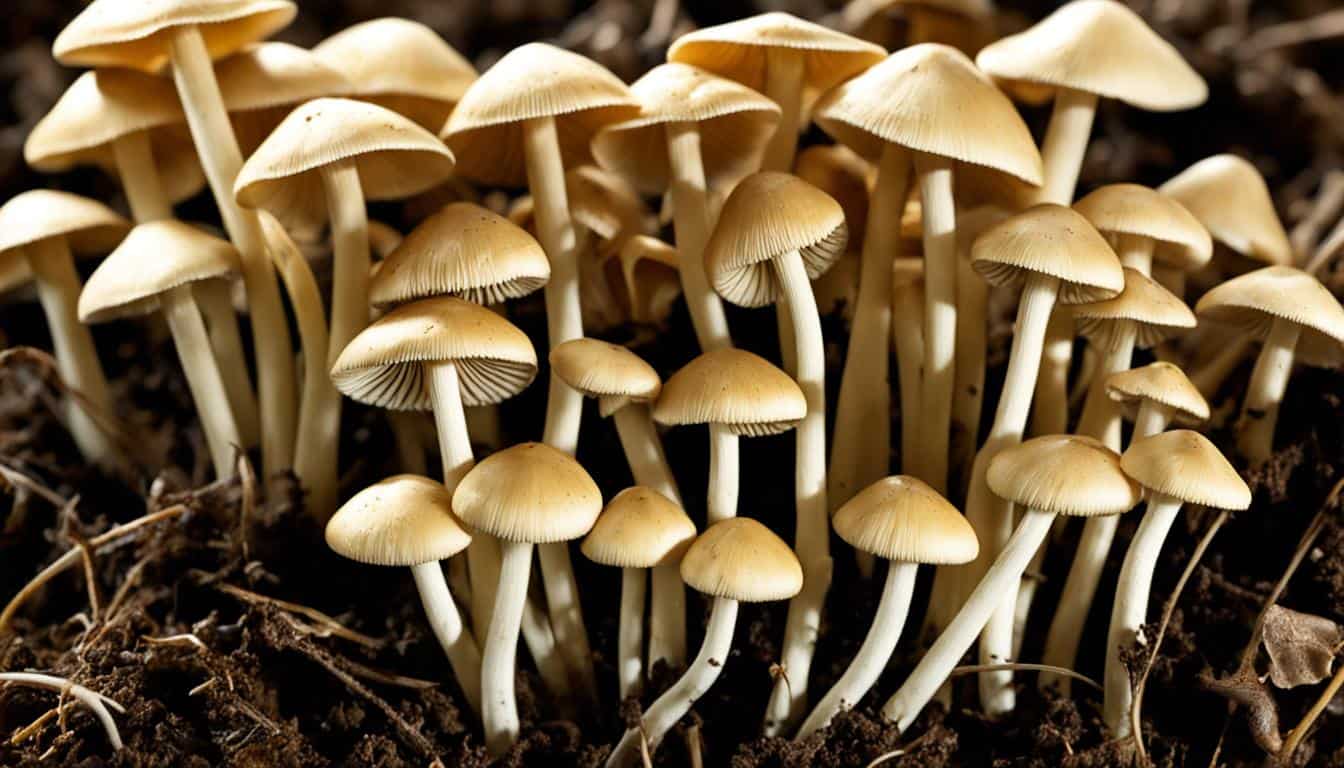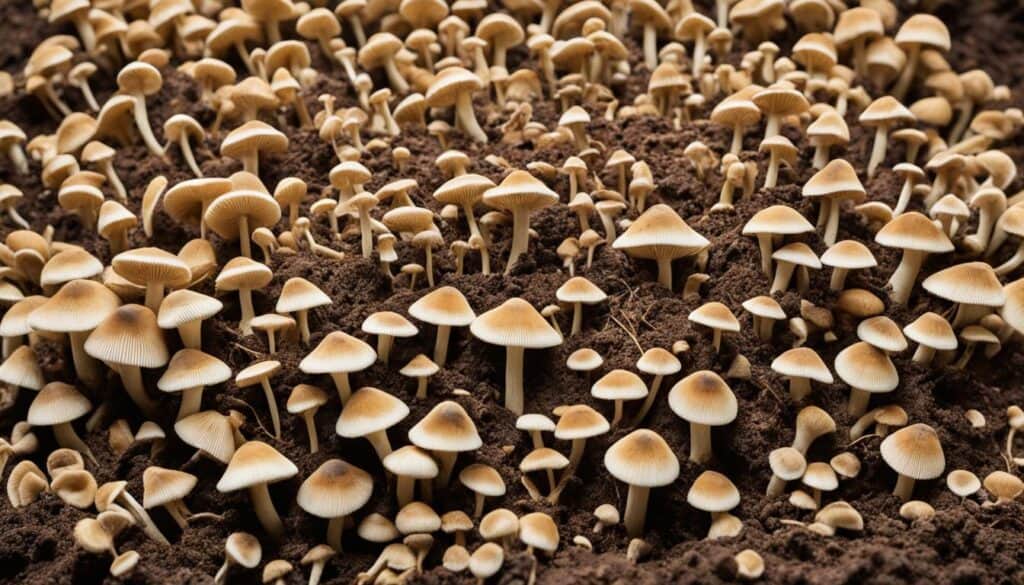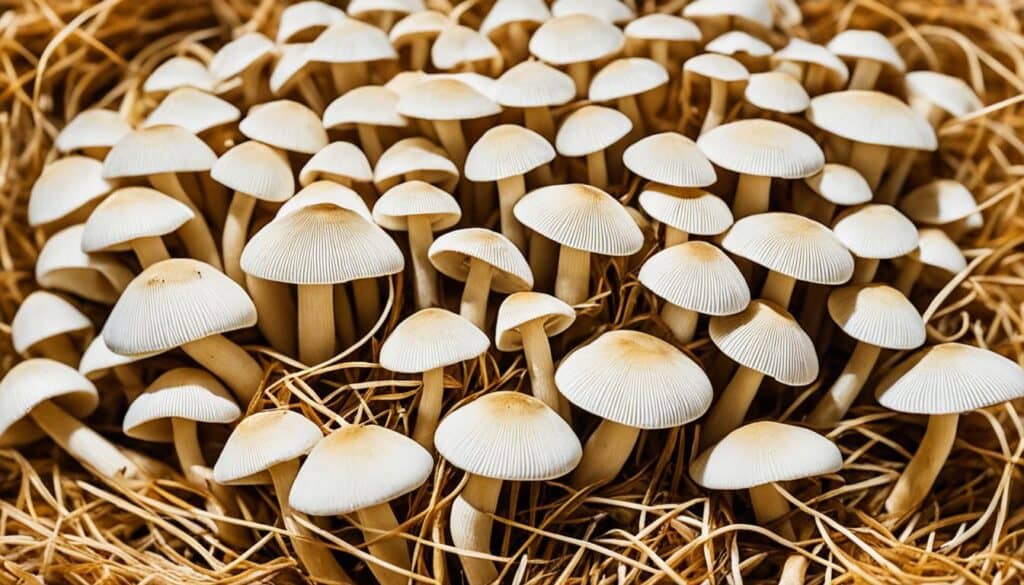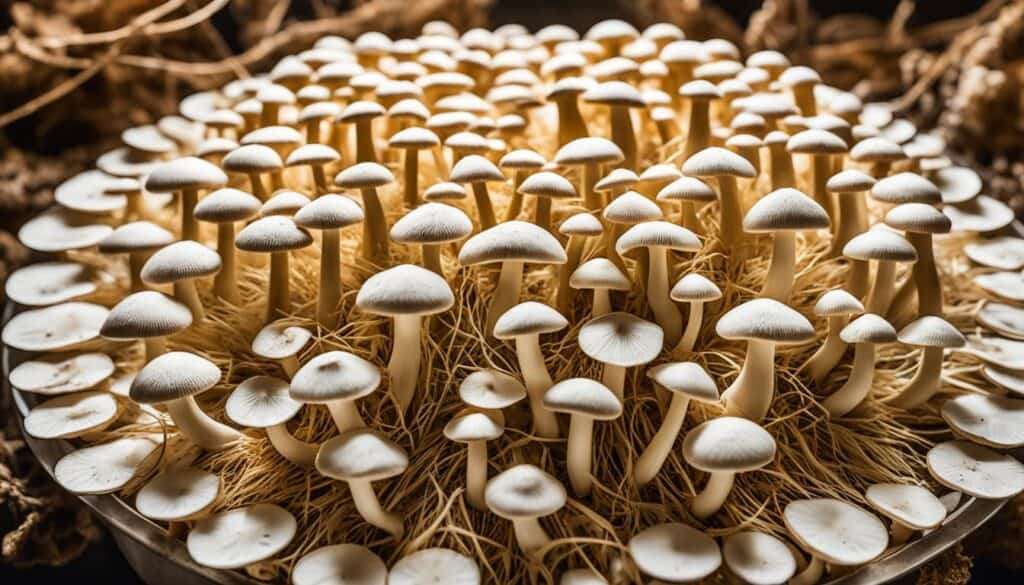Did you know that straw mushrooms, a popular edible mushroom, have been cultivated for over 2,000 years? This humble fungi, scientifically known as Volvariella volvacea, holds immense culinary and nutritional value. From their delicate flavor and versatile use in various Asian cuisines to their sustainable farming practices, straw mushrooms are truly a treasure trove waiting to be explored.
Key Takeaways:
- Straw mushrooms have been cultivated for over 2,000 years.
- They are highly valued for their delicate flavor and versatility in Asian cuisines.
- Straw mushroom cultivation promotes sustainable farming practices.
- These mushrooms offer a wealth of nutritional benefits.
- Exploring the world of straw mushrooms adds a vibrant dimension to culinary creations.
Encounter the Enigmatic – A Brief Introduction to Straw Mushrooms
Straw mushrooms, also known as Volvariella volvacea, are small, ivory-hued mushrooms that have been cherished as a culinary treasure in various Asian cuisines for centuries. These delicate mushrooms are often found in fields or rice paddies and boast a distinct egg-shaped cap. Their unique appearance and subtle flavor make them an exciting addition to the culinary world.
| Culinary Uses | Nutritional Value |
|---|---|
|
|
The Culinary Delights of Straw Mushrooms
“Straw mushrooms add a unique flavor and texture to a wide range of dishes, making them highly versatile in the culinary world. From stir-fries and soups to curries and salads, these mushrooms seamlessly blend into different culinary traditions. Their ability to absorb flavors from other ingredients makes them a favorite among chefs, elevating the overall taste of the dishes they are incorporated into.”
With their delicate nature and mild taste, straw mushrooms provide a captivating culinary experience. Let’s delve deeper into the delightful world of these Asian delicacies and discover the secrets behind their revered status!
Unveiling the Puzzle – The Anatomy of Straw Mushrooms
To truly appreciate the elegance of straw mushrooms, it’s important to understand their anatomy. These mushrooms have a distinctive cap that expands as they mature, reaching a diameter of 2-5 centimeters. Underneath the cap, you’ll find gills, thin blade-like structures responsible for spore production. Straw mushrooms also have a veil, a thin membrane that covers the gills initially and leaves a ring on the stem as it tears. The stem is slender and delicate, offering a delightful crunch when cooked.
| Straw Mushroom Anatomy | Description |
|---|---|
| Cap | The expandable top part of the mushroom, reaching a diameter of 2-5 centimeters. |
| Gills | Thin blade-like structures beneath the cap, responsible for spore production. |
| Veil | A thin membrane covering the gills initially and leaving a ring on the stem as it tears. |
| Stem | Slender and delicate part of the mushroom, offering a delightful crunch when cooked. |
The Craft of Cultivation – Nurturing Straw Mushrooms
Cultivating straw mushrooms is a delicate process that requires meticulous attention to environmental factors. These mushrooms thrive on beds of rice straw, creating an ideal medium for cultivation. The process involves precise management of temperature, humidity, and ventilation to ensure a successful harvest. Straw mushroom cultivation is a well-established practice, providing a sustainable and reliable source of this culinary delight.
The cultivation of straw mushrooms begins with the preparation of the growing medium. Beds made from rice straw provide the perfect nutrient-rich environment for these mushrooms to thrive. The rice straw acts as a substrate, offering essential nutrients and moisture absorption capabilities.
Rigorous temperature control is crucial for successful straw mushroom cultivation. The optimal temperature range for growth is between 75°F and 85°F (24°C and 29°C). Extreme temperatures, both hot and cold, can inhibit growth or cause the mushrooms to develop irregularly.
Humidity plays a vital role in the cultivation process. Maintaining humidity levels between 80% and 90% is crucial to promote mushroom growth and prevent drying out. Adequate moisture ensures the mycelium, the vegetative part of the mushroom, develops and spreads effectively.
Ventilation is another critical factor in straw mushroom cultivation. Sufficient airflow helps regulate temperature and humidity levels within the growing environment, preventing the accumulation of excessive moisture or stagnant air that can encourage the growth of unwanted contaminants.
The cultivation process typically involves the following steps:
- Preparation of rice straw beds
- Spawn inoculation on the beds
- Mycelium growth and development
- Cropping and harvesting
Throughout these stages, careful monitoring of temperature, humidity, and ventilation is essential to ensure the healthy growth and development of straw mushrooms.
By mastering the craft of cultivation, farmers can successfully grow and harvest bountiful crops of flavorful straw mushrooms. The combination of optimal environmental conditions and sustainable farming practices ensures a reliable supply of these culinary gems.
Culinary Marvels – Straw Mushrooms in the Culinary Arena
Straw mushrooms, with their unique flavor and texture, are a culinary delight that effortlessly complements a wide range of dishes. Whether it’s soups, stir-fries, salads, or curries, these versatile mushrooms have the ability to seamlessly blend into different culinary traditions, elevating the overall taste of the dishes they are incorporated into.
Unlike other mushrooms, straw mushrooms have a remarkable ability to absorb flavors from other ingredients, making them a favorite among chefs and home cooks alike. When added to soups, they infuse the broth with a delicate earthy essence. In stir-fries, straw mushrooms maintain their firmness while soaking up and enhancing the enticing sauces. In salads, they offer a delightful contrast and a burst of umami goodness. And in curries, they provide a mellow backdrop for the aromatic spices to shine.
One of the secrets to the culinary success of straw mushrooms is their unique texture. With a tender yet slightly firm bite, they add a pleasant mouthfeel to any dish. Whether it’s a comforting noodle soup, a vibrant vegetable stir-fry, a refreshing summer salad, or a rich and aromatic curry, straw mushrooms effortlessly bring depth and complexity to the plate.
Quotes:
“Straw mushrooms are my go-to when I want to add a touch of earthiness and depth to my stir-fries. They absorb all the flavors and make every bite a delicious experience.” – Chef Emily Wong
Culinary Uses of Straw Mushrooms
| Dish | Culinary Application |
|---|---|
| Soup | Adds depth and umami to broths |
| Stir-fry | Enhances sauces and absorbs flavors |
| Salad | Provides a contrasting texture and umami flavor |
| Curry | Plays a supporting role, adding mellow richness |
Nutritional Riches – The Health Perks of Straw Mushrooms
In addition to their culinary appeal, straw mushrooms offer a rich nutritional profile. They are low in calories and packed with essential nutrients, including vitamins, minerals, and antioxidants. Research suggests that the bioactive compounds found in mushrooms, including straw mushrooms, may offer potential health benefits such as supporting the immune system and displaying anti-inflammatory properties. Adding straw mushrooms to your meals can be a delicious way to enhance your nutritional intake.
Straw mushrooms are not only a tasty addition to your dishes but also a powerhouse of nutrients. They provide a wide range of essential vitamins, including B vitamins such as niacin, riboflavin, and pantothenic acid. These vitamins play a crucial role in energy production, maintaining healthy skin, and supporting brain function.
Their mineral content is equally impressive, with significant amounts of potassium, phosphorus, and copper. Potassium is essential for maintaining proper heart function and controlling blood pressure, while phosphorus is crucial for healthy bones and teeth. Copper, on the other hand, contributes to the production of red blood cells and collagen.
Straw mushrooms are also rich in antioxidants, which help protect the body against harmful free radicals and oxidative stress. These antioxidants, such as ergothioneine and selenium, have been linked to a variety of health benefits, including reducing the risk of chronic diseases and supporting overall well-being.
Apart from their vitamins, minerals, and antioxidants, straw mushrooms are also a source of dietary fiber, which aids in digestion and promotes a healthy gut. Including these mushrooms in your diet can help you meet your daily fiber requirements and maintain a well-balanced digestive system.
Overall, the nutritional profile of straw mushrooms, combined with their delectable taste, makes them a valuable addition to any meal. Whether you incorporate them into stir-fries, soups, or salads, you’ll be reaping the numerous health benefits they have to offer.
Eco-Conscious Fungi – Sustainable Aspects of Straw Mushroom Farming
Straw mushroom farming exemplifies sustainable practices that have a positive impact on the environment. By repurposing agricultural by-products like rice straw, farmers reduce waste and promote eco-friendly practices. The cultivation of straw mushrooms can also be seamlessly integrated into crop rotation systems, which not only enhances soil fertility but also minimizes the need for synthetic fertilizers. By choosing straw mushrooms, you are actively supporting environmentally conscious agricultural practices.
One of the key sustainable aspects of straw mushroom farming is its utilization of agricultural by-products. Rice straw, which is often discarded as waste after the harvest, is transformed into a valuable resource for mushroom cultivation. Instead of contributing to landfill and environmental pollution, farmers repurpose rice straw as a substrate for cultivating straw mushrooms. This innovative approach not only reduces waste but also maximizes the utility of agricultural resources.
Additionally, the cultivation of straw mushrooms can be integrated into crop rotation systems, further enhancing sustainability. Crop rotation involves alternating the cultivation of different crops on the same land, providing numerous benefits such as improved soil fertility, reduced soil erosion, and effective pest and disease management. By including straw mushroom cultivation in the rotation, farmers can take advantage of this practice while also diversifying their agricultural output.
The Advantages of Straw Mushroom Farming in Crop Rotation
- Promotes soil health and fertility by improving nutrient availability and reducing soil-borne diseases.
- Reduces the reliance on synthetic fertilizers, minimizing chemical inputs and their potential environmental impacts.
- Enhances biodiversity by creating more diverse habitats for beneficial organisms like insects and microorganisms.
- Contributes to sustainable pest and disease management by interrupting pest life cycles and reducing disease pressure.
- Provides economic benefits through diversified crop production and increased market opportunities.
Straw mushroom farming’s integration into crop rotation systems reflects a holistic and sustainable approach to agriculture. By combining the cultivation of this versatile mushroom with other crops, farmers can optimize land use and benefit from the mutual interactions between different plant species. This practice not only supports the long-term productivity of the land but also reduces the environmental impact associated with conventional mono-cropping.
| Advantages of Straw Mushroom Farming in Crop Rotation | Benefits |
|---|---|
| Promotes soil health and fertility | Improved nutrient availability and reduced soil-borne diseases |
| Reduces reliance on synthetic fertilizers | Minimized chemical inputs and environmental impacts |
| Enhances biodiversity | Creates diverse habitats for beneficial organisms |
| Contributes to sustainable pest and disease management | Interrupts pest life cycles and reduces disease pressure |
| Provides economic benefits | Diversified crop production and increased market opportunities |
By incorporating straw mushroom farming into their agricultural practices, farmers not only enjoy the culinary benefits of this prized delicacy but also contribute to sustainable and environmentally friendly food production. The utilization of agricultural by-products and the integration of crop rotation systems exemplify the ingenuity and eco-consciousness within the field of straw mushroom cultivation.
Exploring Varieties – Beyond Volvariella volvacea
While Volvariella volvacea is the primary species recognized as straw mushrooms, it’s important to note that there are other mushroom varieties that share similar names. One fascinating variety is Agaricus aestivalis, commonly known as the “straw mushroom,” which offers a distinct appearance and flavor.
Agaricus aestivalis, also referred to as the “summer agaricus,” features a light brown cap and a firm, meaty texture. Its flavor profile is earthy and nutty, adding depth to various dishes. This unique mushroom variety presents an opportunity to expand your mushroom journey and explore a wider range of flavors in the world of edible fungi.
Discovering these variations beyond Volvariella volvacea brings a captivating dimension to your culinary exploration, allowing you to appreciate the diverse and enticing qualities of different mushroom species.
| Variety | Appearance | Flavor |
|---|---|---|
| Volvariella volvacea (straw mushroom) | Small, ivory-hued with an egg-shaped cap | Delicate and subtle |
| Agaricus aestivalis (summer agaricus) | Light brown cap | Earthy and nutty |
Exploring these intriguing mushroom varieties enables you to enhance your culinary repertoire and create dishes with unique flavors and textures. Don’t limit yourself to just one type of straw mushroom when there’s a whole world of mushroom varieties waiting to be discovered!
Conclusion
In conclusion, straw mushrooms are a culinary delight that embodies the perfect fusion of taste, texture, and nutritional value. These versatile mushrooms, scientifically known as Volvariella volvacea, have been cherished in Asian cuisines for centuries and have now captivated the hearts of food enthusiasts worldwide.
With their delicate flavor and unique appearance, straw mushrooms offer a delightful addition to various dishes in the culinary arts. Whether they are used in soups, stir-fries, salads, or curries, these mushrooms seamlessly blend into different culinary traditions, enhancing the overall taste and experience.
Not only are straw mushrooms a culinary delight, but they also support sustainable farming practices. Cultivating these mushrooms involves repurposing agricultural by-products like rice straw, reducing waste, and promoting eco-friendly farming. By choosing straw mushrooms, you contribute to the preservation of our environment and support the future of sustainable agriculture.
Moreover, straw mushrooms offer a wealth of nutritional value. Low in calories yet packed with essential nutrients, including vitamins, minerals, and antioxidants, they contribute to a healthy diet. Incorporating straw mushrooms into your meals is not just a delicious choice but also a nutritious one.
So, let’s celebrate the captivating world of straw mushrooms and savor the culinary delights they bring. From their humble origins to their place in gourmet dishes, these mushrooms continue to amaze and inspire the culinary world.










Leave a Reply